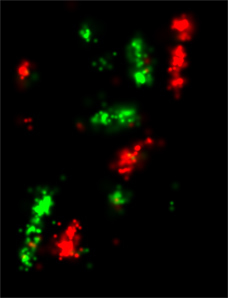Bo Huang, Ph.D.
Assistant Professor, Department of Pharmaceutical Chemistry, Department of Biochemistry and Biophysics, University of California, San Francisco
Nikon-Ausrüstung
Please tell us about your involvement with N-STORM.
I was part of the team that developed the Stochastic Optical Reconstruction Microscopy (STORM) technology, and I have been working closely with Nikon engineers in building up the N-STORM hardware and software. With Nikon N-STORM, we can see things never before imagined. I am very happy to see our lab work turning into a commercial product, which allows many more research groups to have access to this tool in their pursuits to understand the fundamental mechanisms of the biological world.
Please tell us about the possibilities of N-STORM.
They are countless. With a spatial resolution that is more than an order of magnitude better than conventional fluorescence microscopy, STORM enables the observation of subcellular and even sub-organelle structures with unprecedented detail. For many decades, scientists had to rely on indirect methods to investigate biological systems at these scales, leaving many questions unanswered simply because we could not "see." Now STORM makes it possible to address them by direct visualization. This is an opportunity for every one of us to see profound changes in how we understand the inner workings of life.
Besides the much improved resolution, N-STORM has two very important features: 3D imaging, which is often required to resolve intracellular structures, and multicolor imaging, which is essential for studying biomolecular interactions. In addition, it can utilize fluorescent probes identical to how biologists labeled specimens before. These features make N-STORM not only a powerful but also a versatile tool that will find applications in numerous fields of biological and biomedical science.
Please tell us about Nikon and Nikon products.
As a lab focused on both the development of new microscopy techniques and the application of these techniques, we found Nikon instruments a good balance between user-friendliness and customizability. N-STORM offers the robustness and image quality for biologists in our group to perform their everyday experiments. The same microscope also provides the flexibility in design for our physicists to add in or modify components, enabling it to perform new functionalities that have not been previously conceived.
Please tell us about your future research.
In addition to pushing the super-resolution microscopy technology further into live cell observation and molecular-scale resolution, we have had our eye on the application of super-resolution microscopy in cell biology and neurobiology. We are using STORM in combination with Structured Illumination Microscopy (SIM), benefiting from the higher resolution of STORM as well as the fact that SIM puts fewer constraints on the sample. We have set out to study the architecture of subcellular structures such as the centrosome, as well as molecular mechanisms controlling the development of neurons in the central nervous system. In the end, we hope our work will set an example of how super-resolution microscopy can bridge our structural knowledge of macromolecules and their functionalities in the cellular context. There are an infinite number of biological questions that need to be answered. We are pleased that technology like STORM will help scientists begin to answer them.

